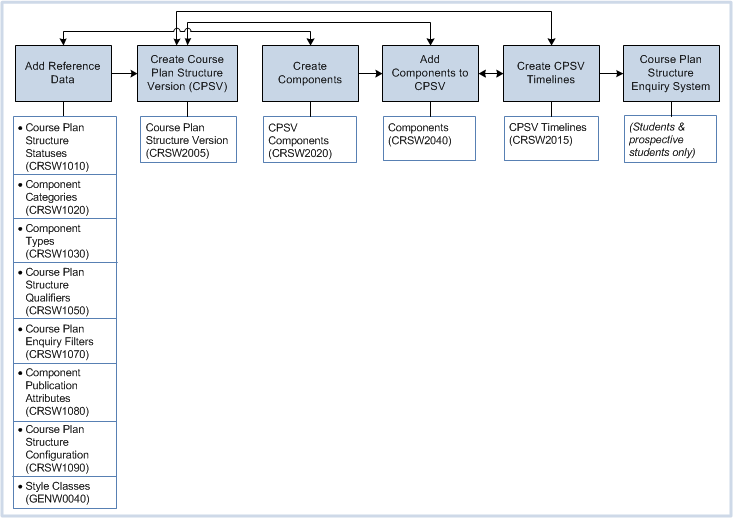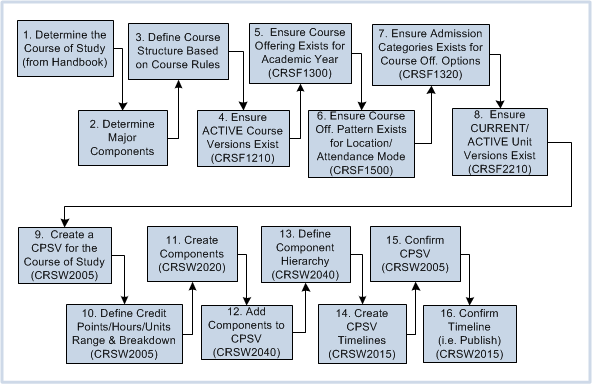
| Table of Contents | Index | Feedback |  |
The Course Plan Structures facility provides higher education and TAFE/VET institutions with the ability to create Course Plan Structures for different courses and pathways of study, as outlined in their Handbooks.
Different Course Plan Structure Versions (CPSVs) are able to be published on the public-facing Course Plan Enquiry system from where prospective students can create a 'Course Plan' for their proposed course of study (i.e. a pathway through a course of study).
A CPSV is made up of a single course and one or more course versions, and multiple Components comprised of a number of units. Once a CPSV is created, one or more Timelines can be created for the CPSV. These are subsequently published on the Course Plan Enquiry system where they may be used by prospective students to plan a pathway through a course of study.
Course Plan Structures are created by authorised administrators only. It is expected that the Course Plan Structure process will be completed by a number of different administrators depending on their assigned security role.
Course Plan Structure Pages
The following diagram shows the Course Plan Structure pages used in creating a Course Plan Structure Version and its related Timelines for publishing on the the Course Plan Enquiry system.

The main steps listed in the diagram above, are explained in more detail, below. (For more information, also see the Course Plan Structure Process section, below):
1. Add Reference Data.
Reference data includes Component Types, Component Categories, Qualifiers, Statuses, Configuration and Style Classes pages. This data determines the way CPSVs are built and how they are displayed in the public-facing Course Plan Enquiry system.2. Create a CPSV (CRSW2005).
A CPSV is made up of an associated course and one or more Components (CRSW2020). It defines information such as the Course, Course Version(s), Published Date, and the maximum and minimum number of credit points, hours or units required to complete the course.3. Create Components (CRSW2020).
Components define details, such as the required number of units or credit points required to complete the defined component of study for a course. Components are added to CPSVs. They can be unique to a specific CPSV or common to multiple CPSVs.4. Add Components to the CPSV (CRSW2040).
Components are added to a CPSV in a hierarchical order. They may be mandatory or optional depending on the assigned Qualifier value. Components added to a CPSV define the number of units, credit points or hours required to complete that component of the CPSV.5. Create Timelines - i.e. Create Timeline Layout (CRSW2015) and Timeline Content (CRSW2015)
A Timeline is grid-structure representing teaching/time periods in which all Components and Units belonging to the CPSV are added. The Timeline is published on the public-facing Course Plan Enquiry system and enables students to schedule units into teaching periods or time periods for their proposed course. Multiple Timelines can be created for a CPSV.6. Course Plan Structure Enquiry System.
Students and prospective students use the public Course Plan Structure Enquiry system to create a 'Course Plan' for a proposed course of study. (For more information, see the Course Plan Enquiry Overview Help page.)
The steps involved in creating a Course Plan Structure begin with determining the course of study (for example, as outlined in the institution's Handbook). The chosen course is broken down into core and elective components, and major sequences. It necessary to ensure that the course and units exist in Callista SMS, and that required Course Plan Structure Reference data has been set up (see 'Add Reference Data' in the Course Plan Structure Pages section, above).
Course Plan Structure Steps
The following diagram provides an example of the sequential steps that may be followed to create a Course Plan Structure.

Return to Top
Related Pages
The following diagram shows the relationship between Course Plan Structure pages, including Reference Data pages, and related SMS Forms.

Return to Top
Last modified on 31 May, 2012 3:57 PM
History Information:
Release Version Project Change to Document 15.0 1722 - Transform 10g to 11g Updated page for 11g. 13.0.0.2 1579 - Course Plan Timelines P2 Updated page - Updated overview image and added step 5. 13.0.0.1 1579 - Course Plan Timelines P1 Updated page, added new diagram. 12.0.0.1 1453 - Course Plan Enquiries Updated page & diagram 11.1 1447 - Course Plan New page.